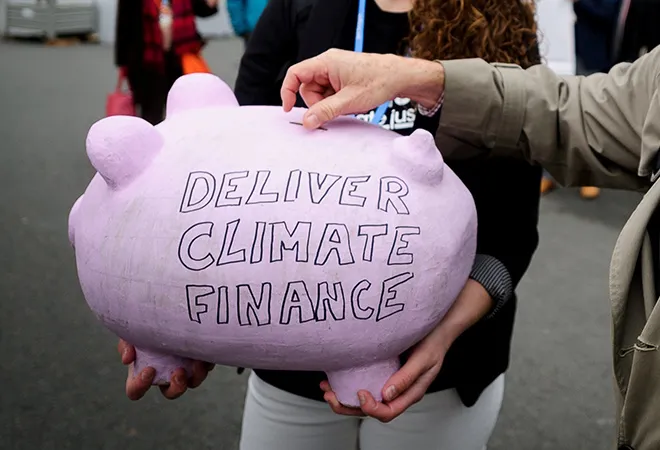
The role of Export Credit Agencies (ECAs) in promoting climate compatible development has been controversial. Despite independent and collaborative efforts from countries ensuring that environment is not an option when their ECAs extend support, fossil fuel financing has shadowed ECAs energy financing portfolio. Oil and Change reports that 88 percent of G20 ECA energy financing went towards fossil fuels. One of the worst performer amongst ECAs of G20 countries is the US EXIM Bank.
The Export Import Bank of the United States is the national official ECA of the US. With the objective of supporting American jobs by promoting the exports of US goods and services, the EXIM Bank pledges to protect the environment. Accordingly, the EXIM Bank, through special initiatives and assistance programmes, provides enhanced financial support for the exports of American-made environmentally beneficial goods and services including renewable energy exports. For instance, through the Bank’s Environmental Exports Programme, certain renewable energy and water transactions are eligible for 18-year repayment terms.
Anecdotal evidences suggests that the Bank’s support has enabled American exporters to walk the globe leaving behind green footprints.
In the overall scheme of things, the EXIM Bank appears to have done well. Anecdotal evidences suggest that the Bank’s support has enabled American exporters to walk the globe leaving behind green footprints.
Yet an inquiry in our paper published by ArtNet (UNESCAP) on the EXIM Bank’s authorisation portfolio paints a relatively different picture. Over a decade — from 2006 to 2016 — the Bank authorised $39,933 million in support of environmentally beneficial exports, of which $2,137 (approximately 54%) was for renewable energy exports. This dollar authorisation towards environmentally beneficial exports and renewable energy exports constituted only 1.83% and 0.98% respectively of the Bank’s total authorisation. Evidently, the Bank’s performance has been dismal at best, and this dismal performance s two presidencies including the final years of George Bush (2006-2007), and the entire Obama presidency (2008-2016).
Several reasons have been argued for the EXIM Bank’s poor performance such as the lapse in the Bank’s full authority from 1 July 2015 to 4 December 2015, and the subsequent uncertainty stemming from a lack of board quorum limiting the Bank’s ability to approve transaction above $10 million; and/or limited scope of existing international rules and regulations governing the changing ECA-financing landscape, amongst others.
For evidence (Agarwal and Wang <2017>Freund <2016>) suggesting that the Bank’s authorisation has had a positive impact on US exports, the US EXIM Bank can play a crucial role in sustaining a climate compatible growth and development. The very reason being exports bear the potential for transmitting technology. Therefore, by providing support for the exports of environmentally beneficial goods and services, the Bank can facilitate the transfer and diffusion of clean and green technologies which might otherwise not have taken place. Consequently, it can facilitate technological advancement, and create an ecosystem of climate conscious firms.
By providing support for the exports of environmentally beneficial goods and services, the Bank can facilitate the transfer and diffusion of clean and green technologies which might otherwise not have taken place.
The example of the US EXIM Bank illustrates important points in the conjunction of international trade, trade financing and climate change. One, ECAs can be effective first policy instruments for facilitating climate compatible development. This conjecture particularly rings true given the scale and nature of investments required to combat climate change, and the need to mobilise and complement public and private investment. Two, in the process of delivering on climate finance readiness, ECAs can help countries deliver on climate change readiness too. ECA-financed-country exports of environmentally beneficial goods and services can help countries to not only acquire climate combating capabilities but also encourage indigenous capability development through the transfer and diffusion of clean and green technologies. Third, for optimal delivery on climate change readiness, ECAs have the potential to foster partnerships wherein the ‘low-cost versus best-value’ term of art, best-value takes precedence over low-cost thus discouraging a race-to-the-bottom competition. ECAs can thus off-set the ‘cheapest-bid-winner’ mentality.
Competition amongst ECAs can overturn the above discussed benefits despite international arrangements such as the OECD Arrangement which seeks to foster a level playing field amongst ECAs and ECA-support. For example, in the ‘low-cost versus best-value’ bid, low-cost can still take precedence if competition amongst ECAs sway demand towards lost-cost projects that provide favourable ECA-support.
Nevertheless, given the current international political complexity surfacing international trade, ECAs can encourage long-term strategic alliances which can form the backbone of a global, concerted effort to tackle climate change. By having progressive targets and ensuring that these targets are met, ECAs can facilitate greater availability and accessibility of tools needed to tackle a changing climate. ECAs climate efforts can further be strengthened by encouraging transparency in ECA-financing, and making available detail project-level data so that analysis can reveal the effectiveness of ECA-financing. Such analysis can provide answer to financial regulators refusing to open their kitty to the country’s ECA. All this, in turn, would not only help countries meet its national renewable targets helping shift away from fossil fuel dependence but also support the objective of international alliances and climate agreements like the International Solar Alliance and Paris Agreement.
Note: Due to paucity of data, the article couldn’t delve into portfolio details of Bank-financed environmentally beneficial exports of goods and services including renewable energy exports.
The views expressed above belong to the author(s). ORF research and analyses now available on Telegram! Click here to access our curated content — blogs, longforms and interviews.




 PREV
PREV


